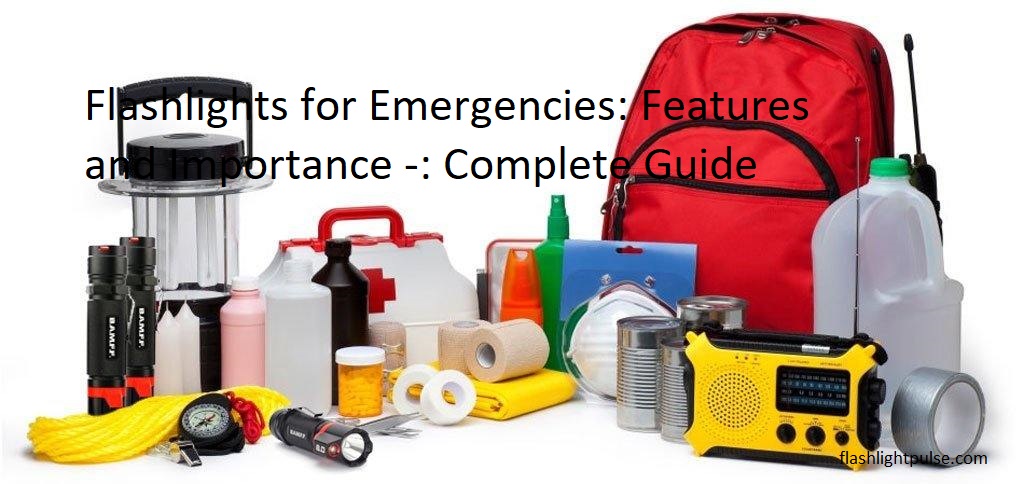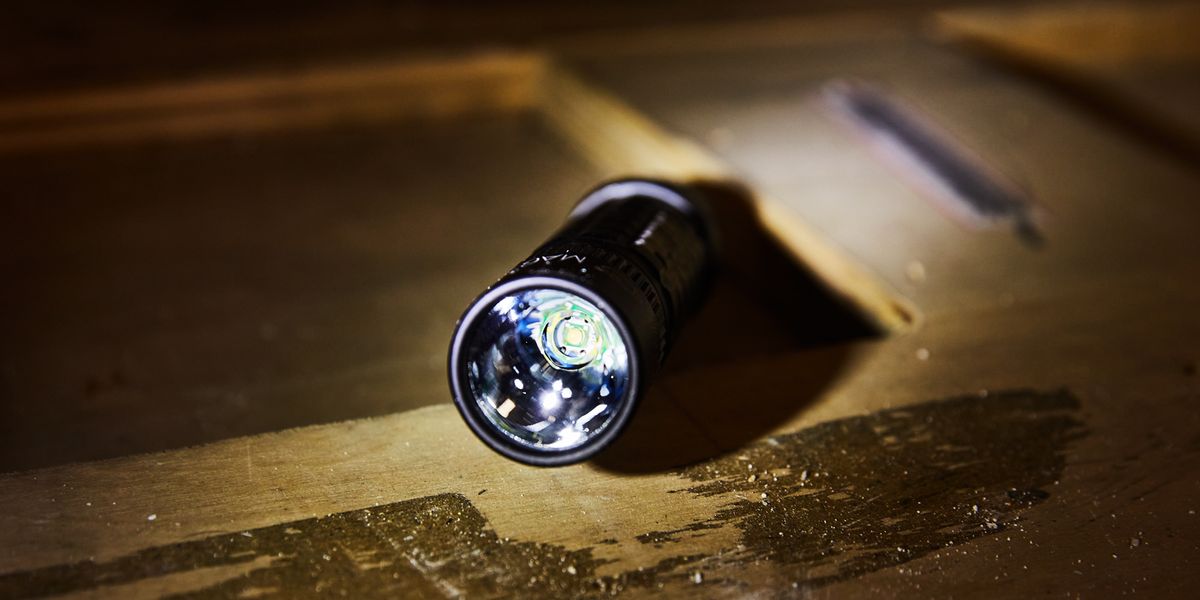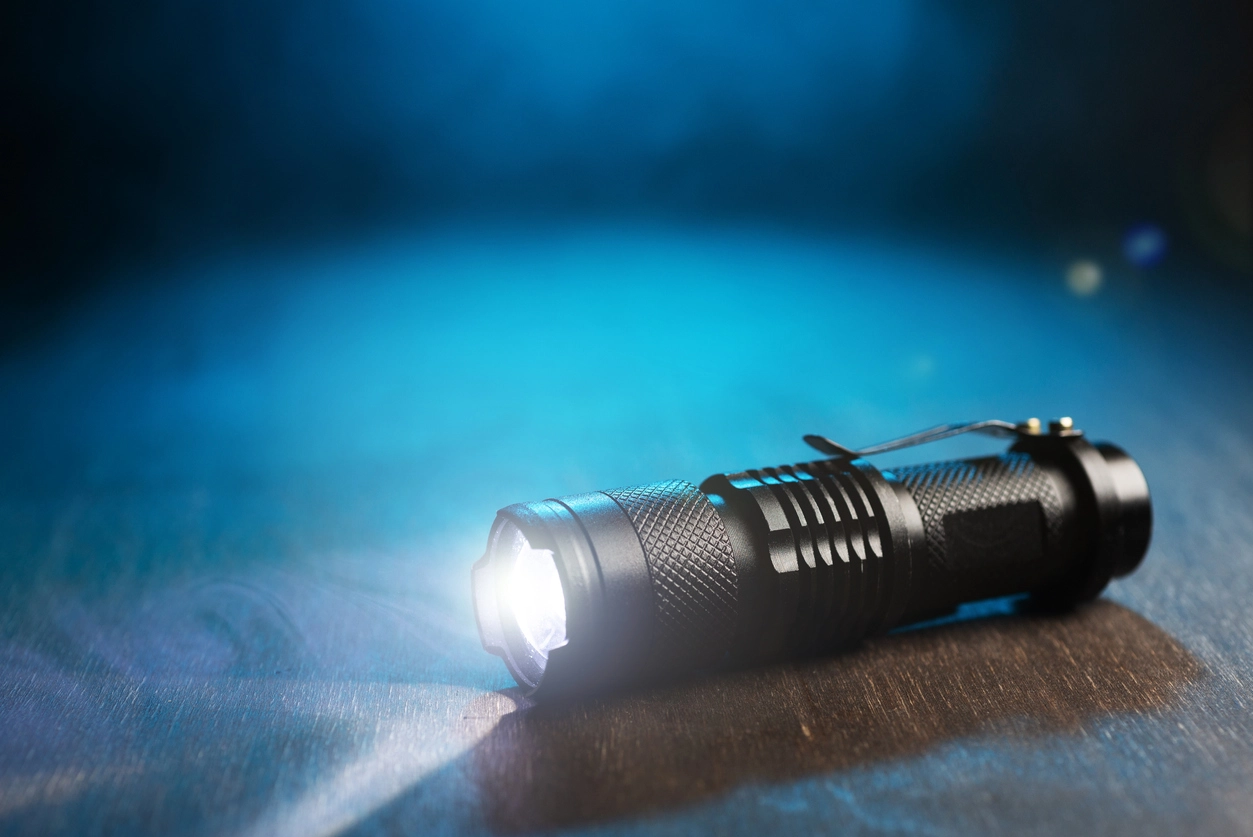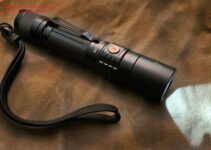In times of emergencies, flashlights are essential. But do you know which features to look for when buying one?
You can stay prepared with this guide to help you understand the importance and features of flashlights!
Flashlights are important pieces of emergency equipment. When used properly, they provide critical light to illuminate dark areas. Flashlights can help users in a variety of situations, including outdoor activities and power outages. Whether you need a small pocket light or a powerful area-illuminating lantern, the right flashlight will help you operate confidently no matter the time of day or night.
It is important to know what features are available and what will best suit your needs before selecting a flashlight for emergency use. Taking into account size, beam type, comfort of use, brightness levels and battery life are key considerations when selecting the right flashlight for your needs. We hope that this guide gives you enough information to make an informed decision when it comes time to choose an emergency flashlight.
This guide covers essential background information about flashlights along with detailed reviews of popular models from reliable manufacturers. It includes descriptions of various common features and their benefits along with safety tips for using your flashlight during an emergency. Finally, we answer some frequently asked questions about flashlights for emergencies so that readers can make sure they get the best lighting solution possible for their unique needs.

Explanation of why flashlights are important for emergencies
Flashlights are an invaluable tool to have on hand in any emergency situation. Not only can they be used to brightly light a dark area, they can also provide an invaluable sense of security and aid in quick navigation away from danger. They can also be incredibly helpful during power outages due to natural disasters, or while out camping or hiking. Flashlights are lightweight, portable and typically require low power input to operate. Knowing the different features and benefits of flashlights is important as it will help ensure that you have the right one for your particular needs.
The main purpose for flashlights is to safely provide enough light for a person to see in the dark- but depending on their design, there are many other related applications. Flashlights with high lumens (measuring brightness) will usually be able to light up larger areas than low lumens models- this makes them suitable for safely maneuvering a room during a blackout. Having focused light beams/lenses allows you to zoom into tight areas, such as small spaces like crawl spaces or vents- which could be necessary in certain cases of rescue operations. Some flashlights even come with LED illumination technology which provides consistent performance over long periods of time and wider coverage compared with traditional incandescent bulbs- making them more appropriate where extended use may be needed. Finally, flashlights with advanced batteries can provide long lasting continuous runtime – reducing time spent trying to find backup power sources during an emergency situation.
In short, having access to a good quality flashlight is extremely important in any emergency situation as it can help you stay better prepared and safe at all times – no matter if you’re dealing with something minor or big disaster outside your home.
Brief overview of the features to be discussed

When it comes to keeping a source of light handy for emergencies, there are several features to consider before investing in a flashlight. It’s important to narrow down the feature list so that you know exactly what you need the flashlight for and what the ideal tool should include. Here is a brief overview of some of the features to be discussed:
-Light output: The brightness and intensity of a flashlight’s beam will vary depending on the model, so it’s important to choose one that has enough light output for your needs.
-Beam distance: Knowing the approximate distance that the beam will travel is key in choosing an effective emergency flashlight –you don’t want one with too short a beam.
-Runtime: The longer runtime, or battery life, of a flashlight is very important when it comes to emergencies. You want to make sure you have enough power on hand when you may not be able to recharge right away.
-Size and weight: Consider how easily portable your flashlight needs to be, as well as how much space is available in your storage area or emergency kit. A smaller, lighter model may serve better in those circumstances.
-Physical design: Depending on how the flashlight fits into your hands can also be an important factor when choosing the right model—some people may prefer rubberized grips while others may find flexible neck models more comfortable and convenient.
Both these factors are highly personal choices that will determine which type of emergency light works best for you.
Key Features of Emergency Flashlights

Emergency flashlights must be versatile and able to perform many different functions. Understanding the key features that are available in today’s modern emergency flashlights will help you choose a model that meets your needs, especially when you need reliable lighting during an emergency situation.
There are three types of emergency flashlights to consider: LED, Halogen and Xenon hybrid models. LED flashlight typically provides the best durability and brightness, lasting longer on one charge than Halogen or Xenon varieties. In addition, LED bulbs require much less energy, resulting in longer battery life.
Different flashlights offer various beam options ranging from spot beams to flood beams. Spot beams increase reach while its focused beam creates clearer lighting over a short distance whereas flood beams cast light over a wider area but with decreased range compared to spot beams. Consider the beam type that suits your needs better before buying an emergency flashlight.
Another useful feature to consider is adjustable brightness settings which allows varying levels of light output for multiple purposes. Emergency flashlights may also come with multiple preset settings for activities such as low light (reading), high light (camping) or SOS signals (distress calls). Many current models now feature rechargeable batteries which can be powered by USB cables or solar panels that are built-in with some advanced models even offering induction charging.
Brightness and Lumens
When shopping for a reliable flashlight for emergency situations, one important factor to consider is the brightness and lumens of the flashlight. Lumens measure how bright and powerful a light source is. Generally, the higher the lumens, the brighter the light that will be produced. Flashlights with higher lumens can cover larger areas and are typically used in search-and-rescue operations. Because of their high output, they are ideal for navigating dark areas or signaling others in medical emergencies and disasters.
The most common range of lumens in flashlights starts at 16 lumens, which is typically used for everyday purposes like illuminating a household keyhole or reading under the covers with minimal disruption to others around you. But for applications needing more power, flashlights can offer up to 2000+ lumens that can easily light up an entire room or outdoors area.
When selecting a flashlight for emergency usage, make sure to keep in mind its lumen output needs and capabilities. Rechargeable models that offer adjustable brightness settings should also be considered as this will help conserve battery life over time while still providing great lighting performance when you need it most!
Durability and Resistance

When thinking of the importance of durable and resistant flashlights for emergency situations, one should consider the features of such flashlights and the benefits they provide.
Durability is usually at the top of the list when it comes to flashlights meant for emergency situations. This ensures that your flashlight will remain functional even if you are in a hazardous environment. Durable flashlights also have a longer lifespan than those with less rugged designs and materials. Look for flashlights made from tough materials, like aluminum alloy or polycarbonate resin, that can withstand wear and tear from frequent use and bad weather conditions.
Another important factor to consider when selecting a reliable flashlight is resistance against water or liquid damage. Any emergency situation you find yourself in may involve getting wet unexpectedly, so look for waterproof ratings on your flashlight to see how well it will stand up in these conditions. Additionally, resistance against temperature fluctuations can help extend its lifespan depending on where you are using it; look for “temperature resistant” ratings as well as “heat proofing” features to determine which models are more suitable than others based on your needs in an emergency situation.
Size and Portability
When selecting a flashlight for emergency purposes, size and portability are important factors to consider. Flashlights come in all shapes and sizes, so it can often be difficult to determine which one is best for you. The size of the flashlight will dictate how easy it is to carry and store as well as how much space it requires. If your main concern is portability, you should prioritize selecting an appropriately sized light that will fit comfortably in your pocket or bag.
Smaller flashlights are ideal if they must be easily carried wherever you go, such as when hiking or camping. In such cases, however, a light that is too small could lead to lower illumination capacity than desired. Many mini flashlights are lightweight and simple to maintain; however, their batteries sometimes cannot last for extended periods of time. It’s best to opt for something that has adequate battery life so you won’t have to constantly swap or charge them throughout the day.
It’s also important to select flashlights with illumination features that fit your needs. Some portable lights offer long-run time and multiple modes of operation for increased visibility in any situation. Additionally, some models have zoom capabilities that make them great for long-distance viewing or detailed work. As such, there’s a vast selection of choices available depending on what you need the most from your flashlight!
Waterproof and Weather Resistance
When considering which flashlight for your emergency kit, durability is a primary factor. Flashlights should be waterproof and sealed from weather elements such as rain and large temperature changes to ensure longevity and functionality. Some flashlights are made with rubber or plastic casings to create a watertight seal while others use an O-ring system.
Weather resistance is another important feature to consider. The ideal flashlight should have an IPX rating of 4 or higher; the higher the rating number, the increased protection against dust and water spray. Look for flashlights marked as waterproof, weatherproof, all-weather or stormproof; these models will typically meet this requirement. Additionally, some lights contain a chemical filling which prevents fogging when exposed to extreme weather conditions.
Flashlights intended for emergency kits should also have an impact-resistance rating which prevents damage when dropped on hard surfaces or hit by debris during storms or floods. Depending on your intended usage, you may even want a model that’s certified for in-water use at depths up to 50 meters (165 feet). Bearing these factors in mind can help you make the best selection for your personal requirements and be better prepared when facing unpredictable storms, floods and unforeseen emergencies.
Importance of Emergency Flashlights
Flashlights are essential for any emergency situation. In times of crisis, having a good quality flashlight can be an immense help to locate items and make sure that you remain safe and secure. They provide light in dark situations, allowing you to see around a dangerous area or locate an item, as well as giving you the opportunity to get help if you need it. Being able to break the darkness and make a path will give comfort and security in these situations.
Having a reliable flashlight also offers a great form of self-defense. The bright light will startle anyone who might attack or put you in danger which might buy you some time or even scare them off completely; it is much more effective than trying to find your way with minimal visibility. Emergencies such as house fires or being stranded on the side of the road can occur at any time, so being prepared with an emergency flashlight is invaluable.
Additionally, they offer practical uses even outside of emergencies such as finding items lost in the dark or just lightening up your area if power goes out. They are easy to carry around due to their light nature and small size, making them perfect for putting away into pockets, luggage bags ,or glove boxes while travelling.
umination during power outages
Power outages can be common during natural disasters or extreme weather conditions. During these emergency situations, having a reliable and powerful flashlight is essential for illuminating any dark areas and providing a source of light for navigating the space. Each person in the home should have their own flashlight should a power outage occur, as there is no way to predict when one will happen. A flashlight should provide enough brightness to illuminate a room and have sufficient run time during an extended outage.
When choosing flashlights for emergencies, it is important to look at features like lumens (the measure of total visible light emitted by the device), beam distance, run time, size and type of battery used. Effective flashlights usually feature LED bulbs that are bright yet energy efficient. To maximize isolation during power outages, many LED flashlights are designed with adjustable focus levels or have lights that can be dimmed down to conserve energy in your home. Rechargeable models can be connected to AC/DC outlets or energized by solar panels if available. Also consider waterproof models as they can protect your gear from water damage if trying to navigate wet environments like flood zones or other natural disasters with bodies of water present.
Aid in search and rescue missions
Search and rescue missions are essential elements of any emergency situation. Flashlights are an invaluable tool for such missions since they can be used to spot hazards in the dark, assess the area for survivors, highlight escape routes and signal for help from others. They can also be used to signal directions or other codes to communication systems.
Many flashlights used in search and rescue operations are equipped with special features such as infrared light (e.g., thermal imaging cameras), laser pointers, adjustable brightness settings, non-slip grip handles, rugged designs to withstand tough conditions, and power sources that last five times longer than ordinary sources.
In addition to being used as a source of light during emergencies, flashlights also serve as a source of comfort and assurance in times of crisis by providing lighting while evacuating people safely through dangerous environments. Moreover, they make survivors feel safe when surveying dark areas when locating beverages or food supplies more quickly due to increased visibility offered by flashlights in low-light situations.
Navigation and signaling
Navigation and signaling are essential and invaluable functions of a reliable emergency flashlight. Many of the newer and more advanced flashlights now come equipped with multiple modes such as broad-reaching light for close inspection of maps, or a focused beam for locating landmarks and navigating in darkness.
Some also offer S.O.S. flashes that can help guide rescuers, especially if you’re lost in an unfamiliar area or inclement weather. Different colors can be used as code to communicate with other people — allowing you to communicate messages quickly even in noisy surroundings.
Even older, simpler flashlights are able to offer basic night-vision capabilities by simply wrapping the light source with a red gel — greatly increasing the ease of movement in complete darkness without compromising safety or stealthy movement.
Conclusion
In conclusion, flashlights provide a level of security and comfort that cannot be obtained elsewhere. Knowing what features to look for when purchasing a flashlight will help ensure you are prepared to handle emergencies with ease. It is important to purchase flashlights that are built with quality components and offer waterproof, reliable illumination.
Buying a flashlight suitable for your specific needs can be the difference between being ready for an emergency and facing unnecessary obstacles. Investing in the right quality of product could save not only your time, but also the security and safety of yourself, your family and even strangers when an emergency arises.
FAQs
What is the importance of emergency flashlight?
An emergency flashlight is important because it provides a reliable source of light during power outages or other emergency situations, allowing for increased visibility and safety.
What are the features of flashlight?
Some common features of a flashlight include a light source (such as a bulb or LED), a battery or power source, a switch or button to turn the light on and off, and sometimes different modes or settings for the light such as high, low, or strobe.
What is the emergency flashlight?
An emergency flashlight is a flashlight that is specifically designed for use in emergency situations, such as power outages or natural disasters. These flashlights are typically more durable, reliable, and long-lasting than regular flashlights.
What are the benefits of using a flashlight?
Using a flashlight can provide increased visibility and safety in low-light or dark environments, and can also be useful in emergencies, outdoor activities, and for inspecting and examining objects in low-light conditions.
What is the importance of emergency light testing?
Emergency light testing is important to ensure that emergency lights are functioning properly and can be relied upon in emergency situations. Regular testing helps to identify and address any issues or malfunctions before they become a problem.
What is the principle of emergency light?
The principle of emergency lighting is to provide a reliable source of illumination during power outages or other emergency situations, allowing for increased visibility and safety.
What is the importance of safety lights?
Safety lights are important because they provide increased visibility and safety in low-light or dark environments, helping to prevent accidents and injuries.
Where is emergency lighting necessary?
Emergency lighting is necessary in any building or facility where people gather, such as offices, schools, hospitals, and public buildings. It is also required by law in many jurisdictions.
Where are emergency lights used?
Emergency lights are used in a variety of settings, including buildings, vehicles, and outdoor areas. They are commonly found in offices, schools, hospitals, airports, and other public buildings, as well as on emergency vehicles such as police cars and ambulances.
Why is it called an emergency light?
An emergency light is called such because it is designed to provide illumination during emergency situations, such as power outages, fires, or natural disasters, when normal lighting may not be available.
See More
- Best 18650 for flashlight 2023
- Best aa flashlight 2023
- Best camping flashlight 2023
- Best edc flashlight 2023
- Best flashlight for emergencies 2023


